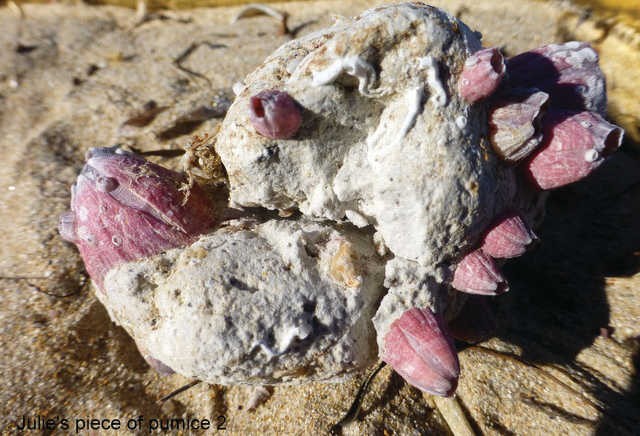
P
A walk along the beach after volcanic activity in the Pacific might see the tide-line strewn with floating rocks.
Pumice is basically aerated volcanic glass. Pumice is created when super-heated, highly pressurized rock is violently thrown from a land-based or underwater volcano. The foamy texture happens because of rapid cooling and depressurization as it is ejected, like the bubbles that appear when a soft drink bottle is opened.
The Havre Seamount volcano, 800 km northeast of New Zealand, produced the largest-known deep ocean volcanic eruption in July 2012. Blankets of rock reached a thickness of 5 meters. The original pumice raft spanned an area of about 23 000 km2. Most of this floating pumice was deposited on the North-West coast of New Zealand and the Polynesia islands. More has been thrown out just in the last couple of months.
The rafts of pumice stones block the sunlight from reaching plankton in the seas beneath. These plankton form the base of food chain when they convert sunlight to food through photosynthesis, and can be severely affected by floating pumice.
The pumice-floats around for long enough for animals to frequently use it as a mobile habitat. Floating rocks can also act as ferries for exotic invading species, such as shellfish and other organisms. Really dense pumice “islands” can exist for years floating along the ocean currents. Some may have been responsible for the distribution of island hopping animals and plants in the Pacific Ocean. Some pumice islands have been found with plants actually growing on them.
A raft appearing off the Low Islets in Queensland were seen to be covered in growth. “Species such as goose and acorn barnacles, molluscs, anemones, bristle worms, hydroids and crabs are just some of the creatures floating along on this volcanic rock. In the past, we’ve seen rafts become home to micro-communities of more than 80 species including corals, and sometimes the weight of the hitchhikers is so great that it causes the pumice to sink.”
Simon Grove, from the Tasmanian Museum and Art Gallery has studied bivalve molluscs and oysters that drifted down to Tasmania on pumice.
Members of the genus Litiopa often live in floating Sargassum weed or on algae attached to floating pumice. Its appearance at Flinders Island in March 2014 was associated with the arrival of large quantities of pumice. They had come from the Havre Seamount eruption on the Kermadec Ridge, (Carey et al. 2014). It was weathered into fist-sized to marble-sized balls, encrusted with goose-barnacles and algae. As it breaks up the cargo of Litiopa and other organisms end up stranded on beaches, eventually finding its way into the shell-grit.
It has been speculated that pumice rafts were the first home that early life on Earth could have clung to and sprung from. Pumice has a large internal surface area and can be a base for a large variety of chemical reactions. It is also able to absorb several biological building blocks and catalysts and concentrate them in a small volume. Pumice coud also have carried important volcanic minerals away from underwater hydrothermal vents. Pumice-lined beaches could provide a long-lasting, thermally-stable environments for abiotic chemistry to occur.

by Hazel Britton and Julie Serafin
